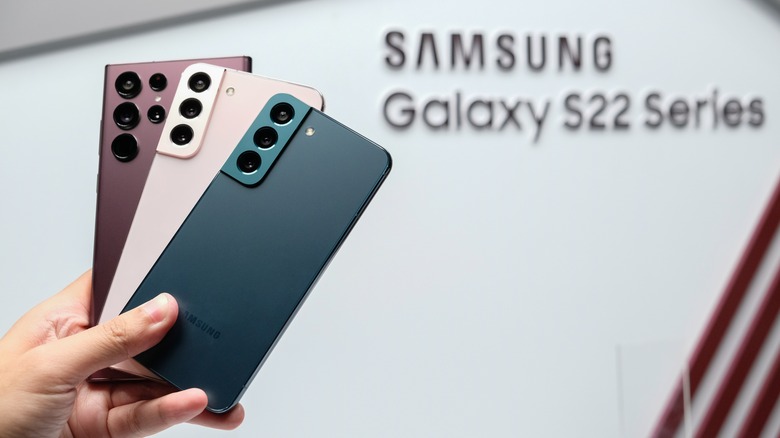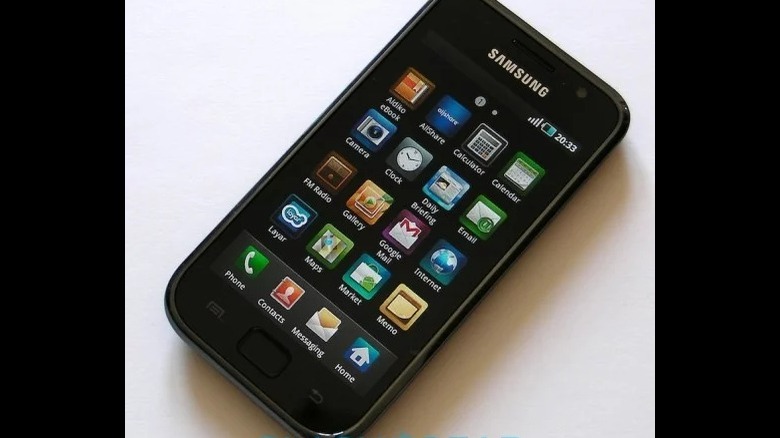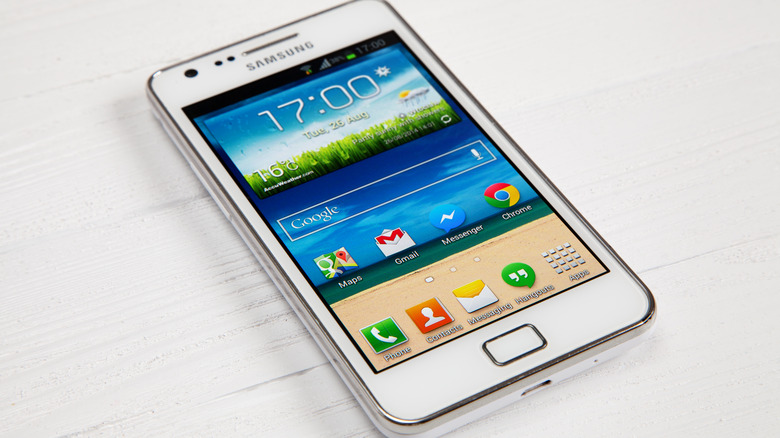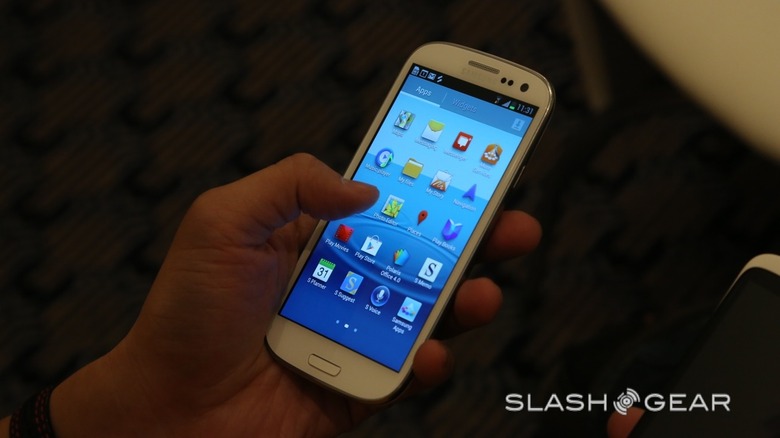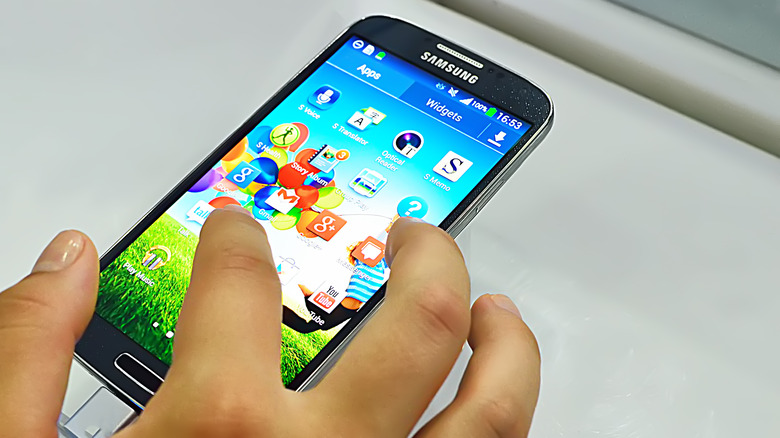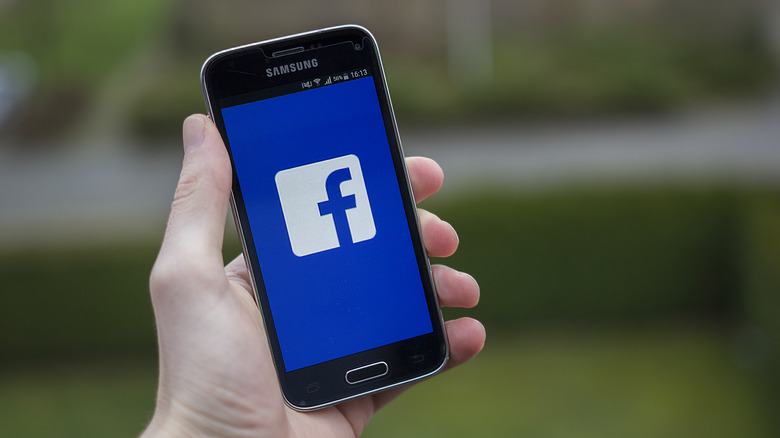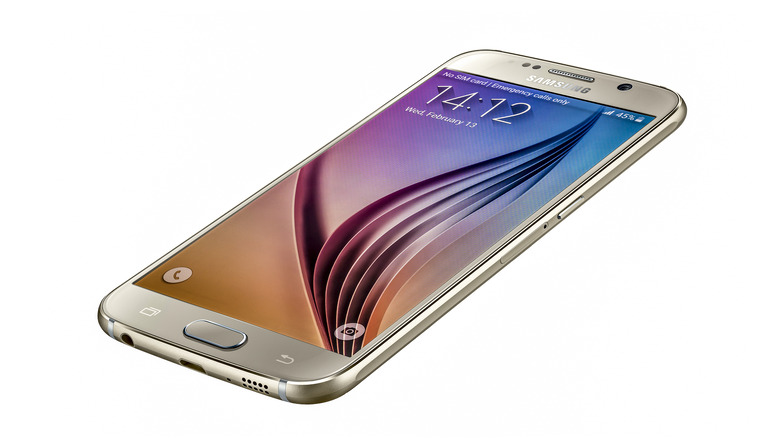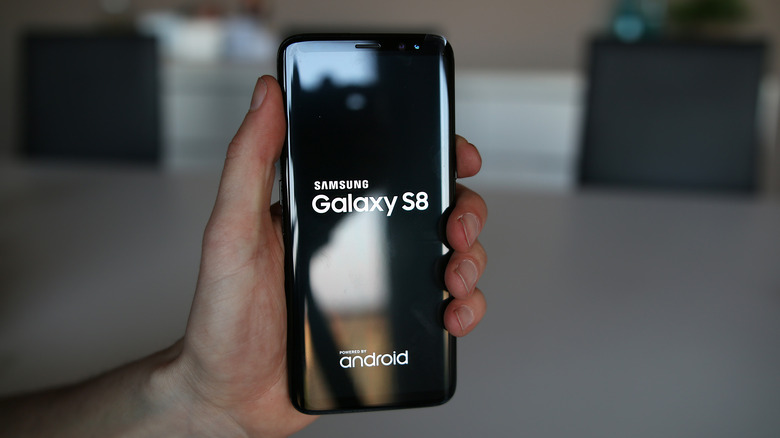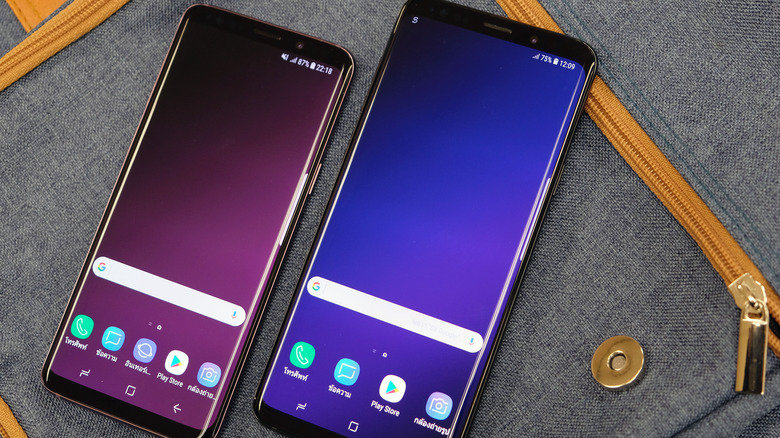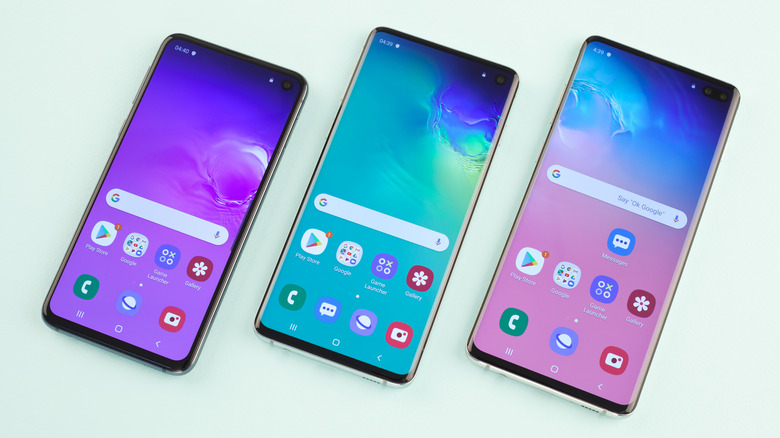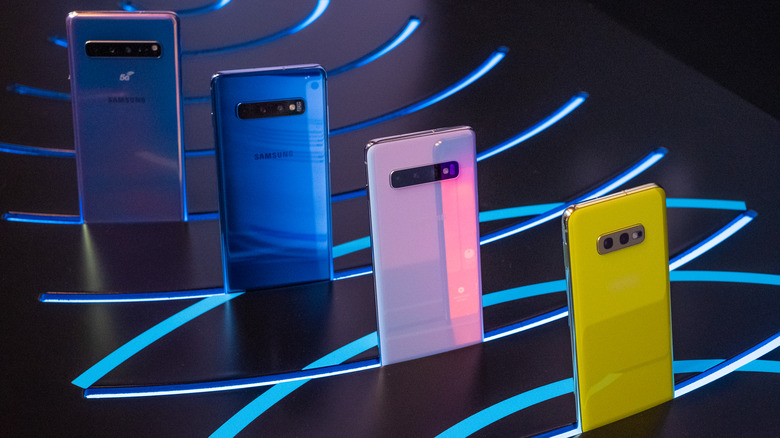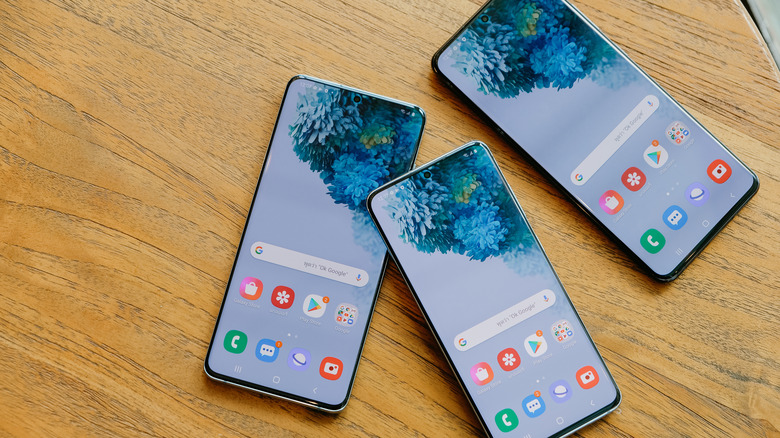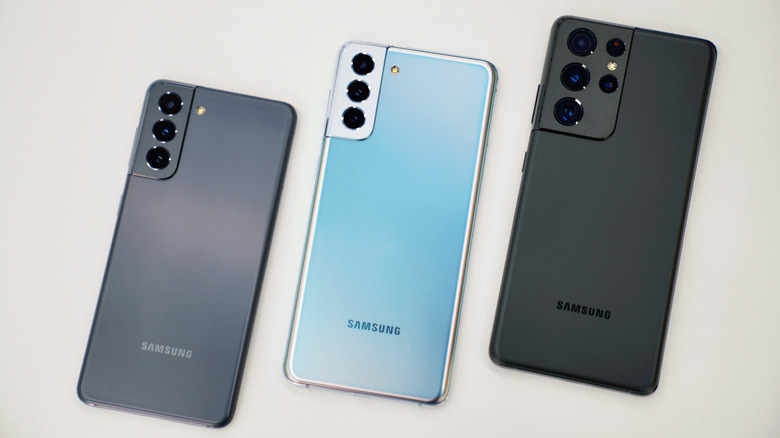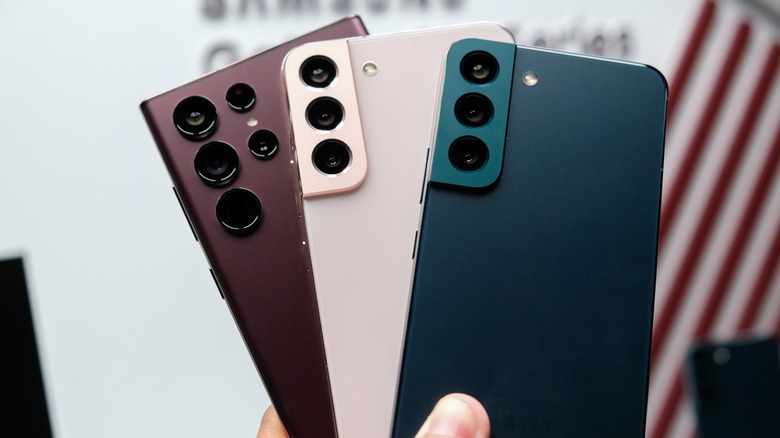Every Samsung Galaxy S Release In Chronological Order
We may receive a commission on purchases made from links.
Samsung's Galaxy S line of smartphones is currently one of the best-selling options on the market, right up there with Google's Pixel phones and Apple's iPhones. The very first Galaxy S phone from Samsung was released in 2010, and quite a bit has changed between the first model and the most recent addition to the line: the Galaxy S22 series.
For reference, Apple released its first iPhone in 2007, so the company had a slight edge over Samsung in the market for touchscreen phones without an external keyboard. But Samsung's Galaxy S line of phones quickly became a fan favorite, especially with the growing debate between iOS and Android.
While the competition may have been slightly tilted in Apple's favor back in 2010, it's since leveled out. Samsung has consistently listened to its users by making the user interface easier to navigate, adding features that make your daily life easier, and upgrading the specs to a stunning degree for a reasonable price.
There were a lot of ups and downs on the path from the first Galaxy S smartphone to the Galaxy S22 series users fawn over today. Let's take a look at exactly how this popular smartphone evolved over the years.
Samsung Galaxy S
The original Galaxy S phone was released in 2010. For context, the iPhone 4 was released around the same time, and the Galaxy S immediately proved to be a worthy Android competitor.
Larger displays are more of a modern smartphone feature, but the Galaxy S's 4-inch screen still looked impressive with a Super AMOLED display. Inside was 512MB of RAM, 2GB to 16GB of total storage (with options of up to 32GB of expandable storage), and Samsung's own Exynos 3 processor, which was then referred to as a Hummingbird processor. The phone's CPU, along with pretty much everything else, was on par with what Apple offered in the iPhone 4.
In 2010, it was common for the back cover to come off and for users to be able to replace the lithium battery if their old one just couldn't hold a charge, and the Samsung Galaxy S had both features. Its 1500mAh battery lasted for about two days during SlashGear's initial tests back in 2010.
While the Galaxy S's cameras are nothing compared to what modern-day Galaxy smartphones offer, they were impressive for 2010. The 0.3MP front camera was mediocre but got the job done. The 5MP rear camera took crisp, well-lit photos and had an autofocus feature to help users out.
Samsung Galaxy S II
Roughly a year later, Samsung announced the Galaxy S2. After the success of the first phone in the line, the public was excited to see how the company improved on an already great device. At about $150 more than its predecessor, the Galaxy S2 was more powerful in all the right ways.
Samsung boosted the display to 4.3 inches with Super AMOLED Plus. Storage options were 16GB or 32GB, with the option to expand up to 32GB with a microSD card. RAM just about doubled at 1GB, and the dual-core Exynos 4 processor helped the phone perform with less lag.
Battery capacity jumped to 1650mAh, and it still lasted about two days after enduring SlashGear's testing, which included the phone being at maximum brightness, lots of photography, and email push notifications turned on. The battery and the back cover are both replaceable on the Galaxy S2.
Thankfully, Samsung paid attention to camera upgrades too. The 8MP rear camera was s significantly improvement, able to film video in 1080p resolution instead of 720p. The selfie camera also got a boost, from 0.3MP to 2MP, and was located at the top center instead of the top right.
In 2013, Samsung released the Galaxy S2 Plus with a slightly different chipset and only 8GB of internal storage instead of 16GB or 32GB. It also came in a new color, Pebble Blue, and featured the TouchWiz "Nature UX" user interface.
Samsung Galaxy S III
The Galaxy S3 was announced in 2012 and went on to become one of the most sold models of the S series. Even though it was only $50 more expensive than the Galaxy S2, the S3 received an improved processor, larger screen, bigger battery, and many useful software features.
The Galaxy S3 sported a 4.8-inch Super AMOLED display powered by a 2100mAh user-replaceable battery. It had 1GB of RAM, options of 16GB, 32GB, or 64GB for storage (with optional expansion via a microSD card), and its proprietary quad-core Exynos 4 processor or Qualcomm's dual-core Snapdragon S4, depending on where in the world you lived. Front and rear cameras were the only specs that didn't see improvement.
One of its most notable features is the split-screen feature that first showed up on the Galaxy Note 2; though the Galaxy S3 didn't see this feature until an update to Android 4.1 pushed through later in 2012. The split-screen feature allows users to use two apps on one screen at the same time. You could also view certain videos in a resizable pop-up window while you were doing something else on your phone.
The Galaxy S3 was also the first Samsung smartphone with support for wireless charging, though you had to purchase an additional kit. Among a few other small improvements, Galaxy S users could take advantage of a personal voice assistant for the first time, titled S Voice.
Samsung Galaxy S4
Samsung's Galaxy S4 only jumped in price an extra $50 from its predecessor, but it came with significant improvements. The Galaxy S4 boasted new sensors to help users get more out of their smartphones, including an accelerometer, a gyroscope, a digital compass, a thermometer, a moisture-measuring hygrometer, and a pressure-tracking barometer.
Storage options included 16GB, 32GB, or 64GB, plus extra storage via a microSD card, RAM doubled to 2GB, and the battery capacity increased to 2600mAh and could be replaced if necessary. Then, the next-gen Galaxy S phone received the newest Exynos 5 Octa 5410 with eight cores for premium performance.
The rear camera went from 8MP on the Galaxy S2 and S3 to a crisp 13MP on the Galaxy S4. You could also record video in 4K at 30 frames per second with the rear camera. Then, the 2.1MP front camera didn't see too much improvement, but you could record 1080p video at 30 frames per second with it. You could view all your photos on the stunning 5-inch Super AMOLED display.
While the Galaxy S4 was the best-selling version, there were a few other variations offered throughout 2013. The S4 Active was marketed as a water-resistant model for super active and outdoorsy people. The S4 Mini was smaller and more affordable, and the S4 Zoom had an optical zoom lens with 10x magnification.
Samsung Galaxy S5
The Samsung Galaxy S5, released in 2014, didn't change much in price and was more of a refinement of the S4 than a next-gen improvement. The S5 got rid of specific sensors like the thermometer and hygrometer and added more useful features, like a heart rate monitor and a fingerprint scanner. The S5 was also the first to have an official IP67 rating for water resistance.
It had a 5.1-inch Super AMOLED display with a 1920 x 1080 resolution, 16GB or 32GB of internal storage (more with a separately purchased microSD card), and 2GB or 3GB of RAM. Some versions had Samsung's proprietary Exynos 5 Octa 5422 processor, while others had Qualcomm's Snapdragon 801 or 805. The S5 is also the last model in the series that lets users replace the battery, which had a capacity of 2800mAh.
Amateur photographers and videographers absolutely adored the Galaxy S5 because of its rear camera upgrades. The 16MP rear camera produced awesome photos and could record in 4K at 30 frames per second or 1080p at 60 frames per second. You could also record a slow-motion 720p video at 120 frames per second.
The Galaxy S5 is also the last model of the series with a micro-SIM card; all future Galaxy S smartphones use a nano-SIM card instead. Other variations of the S5 include the S5 Mini, S5 Active, and S5 Sport.
Samsung Galaxy S6
Samsung's Galaxy S6 marked a lot of firsts. Released in 2015, it was the first to have a nano-SIM card instead of a micro-SIM card, the first to lack a MicroSD slot, and the first to have a smaller and non-replaceable battery. Samsung dropped cheap plastic and swapped it for a new metal and glass build that felt more premium.
In addition to the Galaxy S6, Samsung released three other models: the S6 Edge, the S6 Edge+, and the S6 Active. Because people couldn't expand storage with a microSD card, internal storage options were larger: 32GB, 64GB, or 128GB. The Galaxy S6, S6 Edge, and S6 Active featured 3GB of RAM, while the Edge+ had 4GB. All versions had Samsung's Exynos 7 Octa 7420 processor inside.
The S6 Edge+ was the only phone that received a larger 5.7-inch display. All other S6 models had the same 5.1-inch display size as the Galaxy S5. The S6 had a 2550mAh battery; the S6 Edge only had a slightly larger 2600mAh battery; the S6 Edge+ featured a 3000mAh battery; and finally, the S6 Active had a capacity of 3500mAh.
The rear camera featured optical image stabilization and a brighter aperture that made low-light photography and videography easier. The front camera went from 2.1MP to 5MP and could record video in 1440p resolution at 30 frames per second.
Samsung Galaxy S7
The Samsung Galaxy S7 series, launched in 2016, includes the S7, S7 Edge, and S7 Active. Unlike the S6, the S7 devices included water resistance and a microSD card slot for extra storage. Galaxy S7 phones also had the option of an always-on display to show certain info, like the date and time, without turning your phone's screen on.
Specs didn't change much from the S6 series. Storage options stayed the same at 32GB, 64GB, and 128GB, though now you could add extra storage through a microSD card. The S7 and S7 Active had a 5.1-inch Super AMOLED display, while the S7 Edge had a larger 5.5-inch display. All phones in the Galaxy S7 series had 4GB of RAM.
S7 smartphones in the United States were equipped with Qualcomm's Snapdragon 820 processor, while other areas received Samsung's Exynos 8890 processor. The non-replaceable battery continued in this series, with a 3000mAh battery for the S7, a 3600mAh battery for the S7 Edge, and a 4000mAh battery for the S7 Active.
Though Samsung dropped the rear camera to 12MP from 16MP, the company did so to get a larger pixel size on the sensor, allowing S7 smartphones to capture more light than S6 smartphones. This made taking great photos in low-light conditions easier. The front camera also received a brighter aperture.
Samsung Galaxy S8
The Samsung Galaxy S8 series included the S8, S8+, and S8 Active, and launched in 2017. All previous Galaxy S series smartphones had a 16:9 aspect ratio for the display, but the S8 series premiered with an 18:5:9 aspect ratio. The Galaxy S8 smartphones had the largest displays to date; the S8 had a 5.8-inch display and the S8+ had a 6.2-inch display, both with Super AMOLED tech.
S8 series phones had 4GB of RAM and only one storage option of 64GB, with an option of expandable storage up to 256GB with a microSD card. Customers in the United States got to experience Qualcomm's Snapdragon 835 processor, while customers in other areas experienced Samsung's Exynos 8895 processor, both of which had eight cores. The front camera was boosted to 8MP, but the rear camera stayed the same at 12MP. The S8 had a 3000mAh battery and the S8+ had a 3500mAh battery.
While the internal specs didn't change a whole lot from the S7 series, there were some smaller improvements and changes made to the S8 series. S Voice was replaced by Bixby, the MicroUSB port was replaced with a USB-C port, and the physical buttons (like the home button) were replaced with on-screen keys. Galaxy S8 series phones also featured an iris scanner.
Samsung Galaxy S9
Released in 2018, the Galaxy S9 series only featured two phones: the S9 and the S9+. This was the first time in the Galaxy S series with big differences between the standard version and the premium version. Both smartphones, however, showed improvements to the camera, the fingerprint scanner location, and video recording in 4K at 60 frames per second, 1080p at 240 frames per second, and super slow motion at 960 frames per second for a short time.
The Galaxy S9 had a 5.8-inch Super AMOLED display with an 18:5:9 aspect ratio, 4GB of RAM, options of 64GB or 256GB of internal storage (plus extra with a microSD card), a 3000mAh battery, and Qualcomm's Snapdragon 845 processor. Then, it has a 12MP rear camera and an 8MP front camera.
The Galaxy S9+ had the same display and resolution specs but was slightly larger at 6.2 inches. It also had the same processor and storage but has 6GB of RAM and a larger 3500mAh battery. While its front camera was the same as the S9, the rear camera setup was equipped with an extra 12MP telephoto lens.
Samsung Galaxy S10
Samsung's Galaxy S10 series featured five different options. In 2019, the series included the S10e, S10, S10+, and S10 5G. Then, the Galaxy S10 Lite released in early 2020, featuring the same cameras and general performance, but with fewer features at a more affordable price point.
The biggest new features on S10 series smartphones include an ultrasonic in-display fingerprint scanner instead of a physical scanner on the back, an ultrawide camera lens, reverse wireless charging, and Samsung's One UI software with Android 9 Pie. Samsung also debuted its first hole-punch selfie camera design in the S10 series, rather than a notch design.
The S10e, S10, S10+, and S10 5G all had a 12MP rear wide camera and a 16MP ultrawide camera, and the S10e was the only phone that didn't also have a 12MP telephoto lens. The S10 Lite, though, had a 48MP rear wide camera, a 12MP ultrawide camera, and a 5MP macro lens. The S10 Lite featured a stunning 32MP front camera, but all other models had a 10MP front camera, which was still an improvement from the S9 series. The S10+ and S10 5G phones had a secondary 8MP front-facing camera.
Then, all Galaxy S10 phones were powered by Qualcomm's Snapdragon 855 processor, though some regions saw Samsung's Exynos 9820 processor. The S10 Lite had a Super AMOLED display, and all other phones in the S10 series had a dynamic AMOLED display. Other than that, each model had unique specs.
Samsung Galaxy S10 Variations
The Galaxy S10e had a 5.8-inch display with a 19:9 aspect ratio, up from the previous 18:5:9 ratio in the S9 series, a 3100mAh battery, 6GB or 8GB of RAM, and 128GB or 256GB of storage, with an option of extra storage via a MicroSD card. The S10e had a side-mounted fingerprint sensor and support for Wi-Fi 6.
Next, the Galaxy S10 had a 6.1-inch display with the same 19:9 aspect ratio, but a higher resolution of 3040x1440. It had a larger 3400mAh battery, 8GB of RAM, an option between 128GB or 512GB for internal storage, an expandable storage microSD slot, and support for Wi-Fi 6. In contrast to the S10e, the S10 had an ultrasonic fingerprint sensor.
The Galaxy S10+ featured a 6.4-inch display with the S10's aspect ratio and resolution. The S10+ also offered a model with a whopping 1TB of storage, plus extra if you bought a MicroSD card. It had a 4100mAh battery, an ultrasonic fingerprint scanner, and either 8GB or 12GB of RAM.
The 6.7-inch display gave the Galaxy S10 5G the largest display of any Galaxy S series phone to date, with the same aspect ratio and resolution as the S10 and S10+, 8GB of RAM, a 4500mAh battery, an ultrasonic fingerprint sensor, and options between 256GB and 512GB for internal storage.
The Galaxy S10 Lite matched the S10 5G's screen size but had a 20:9 aspect ratio and a lower resolution. It also had the same large 4500mAh battery but skimped on internal storage and RAM. You could choose between 6GB and 8GB for RAM. You could get expandable storage through a MicroSD card, though there was only one option for internal storage: 128GB. Also, instead of an ultrasonic fingerprint sensor, the S10 Lite had an optical fingerprint sensor.
Samsung Galaxy S20
In early 2020, Samsung launched the Galaxy S20 series with the S20, S20+, and S20 Ultra, and then later in 2020 released the budget-friendly S20 FE.
Displays received a massive upgrade, with a super smooth 120Hz refresh rate and Dynamic AMOLED 2X displays with a 20:9 aspect ratio. The S20 FE differed slightly with its Super AMOLED display. The S20 series, excluding the S20 FE, was also the first to feature 8K video recording.
The S20 had a 4000mAh battery, followed by a 4500mAh battery in the S20+ and S20 FE, and then by the S20 Ultra with its huge 5000mAh battery. All S20 series smartphones were equipped with Qualcomm's Snapdragon 865 or the comparable Exynos 990 from Samsung for stunning performance, especially when paired with that speedy 120Hz refresh rate.
Samsung's S20 comes with 128GB of internal storage, and the S20 FE offers 256GB. The S20+ and S20 Ultra offer three options for storage: 128GB, 256GB, or 512GB. All support a MicroSD for expandable storage up to 1TB. Then, the S20, S20+, and S20 FE all offer 8GB of RAM, though, for the S20 and S20+, the 8GB option is only the 4G LTE version. For the 5G versions, as well as the S20 Ultra, there's 12GB of RAM. The S20 Ultra also offers an impressive 16GB option.
The front-facing camera for the S20 and S20+ was 10MP, the S20 Ultra had a 40MP front camera, and the S20 FE had a 32MP front camera. Samsung's S20 and S20+ shared the same rear 12MP wide camera, a 64MP telephoto lens, and a 12MP ultrawide lens. The S20 FE had the same 12MP wide camera and 12MP ultrawide lens, but an 8MP telephoto lens. The S20 Ultra offered a 108MP wide camera, 48MP telephoto lens, and 12MP ultrawide lens.
Samsung Galaxy S21
In 2021, Samsung released the Galaxy S21, S21+, and S21 Ultra. The mid-range S21 FE launched in early 2022 with similar cameras and performance, but fewer features. Like the Galaxy S6 series, the S21 series lacks a MicroSD slot.
The S21 smartphones are the first series in the whole Galaxy S line to feature only 5G models and an adaptive refresh rate that spanned 10-120Hz. This series was able to drop the MST technology previously used for Samsung Pay, which meant Galaxy S smartphone users could pay without needing NFC.
S21 series displays featured the adaptive refresh rate, dynamic AMOLED 2X tech, and a 20:9 aspect ratio. The S21 had a 6.2-inch screen, the S21+ had a 6.7-inch screen, the S21 Ultra had a 6.8-inch screen, and finally, the S21 FE had a 6.4-inch screen.
Each S21 smartphone had either Qualcomm's Snapdragon 888 processor or the Samsung Exynos 2100 processor inside. Storage and RAM options were similar to those of the S20 series, ranging from 8GB to 16GB of RAM and 128GB to 512GB of storage.
The battery capacity and cameras of the S21 smartphones are awesome. The S21 had a 4000mAh battery; the S21+, 4800mAh; the S21 Ultra, 5000mAh; and the S21 FE, 4500mAh. The S21 and S21+ phones shared the same camera setup, which included a 10MP front camera, 12MP rear wide camera, 64MP telephoto camera, and 12MP ultrawide camera. The S21 FE also had 12MP rear wide and ultrawide cameras but differed with its 32MP front camera and 8MP telephoto camera.
But for stunning cameras, you'd splurge for the S21 Ultra's 108MP rear wide camera, two 10MP telephoto lenses, 12MP ultrawide lens, and 40MP front-facing camera.
Samsung Galaxy S22
The Galaxy S22 series is the latest entry in Samsung's popular line of smartphones and released in early 2022 with the S22, S22+, and S22 Ultra. The aspect ratio was once again changed, this time to 19:5:9, and the adaptive refresh rate now ranges from 1-120Hz.
Another major change for the S22 series is the design. Though the S22 Ultra received the biggest design change, resembling a Note device more than a Galaxy S device, all of the S22 phones look and feel more premium. The S22 and S22+ now have glass backs, and all S22 smartphones feature Samsung's Armor Aluminum and Gorilla Glass Victus+ for extra strength.
All displays in the S22 series feature Dynamic AMOLED 2X tech and are powered by Qualcomm's Snapdragon 8 Gen 1 processor or Samsung's Exynos 2200 processor. The S22 and S22+ also share 8GB of RAM and options of 128GB or 256GB of storage, with no MicroSD card slot available for extra storage. The S22 Ultra has larger 512GB or 1TB options for storage in addition to the smaller options.
Surprisingly the Galaxy S22 features a smaller battery capacity at 3700mAh, more in line with the S10 series than any of the newer options. The S22+ has a 4500mAh battery, and the S22 Ultra has a 5000mAh battery.
Like usual, the S22 and S22+ share the same camera setup, including a 50MP rear wide camera, a 10MP telephoto lens, a 12MP ultrawide lens, and a 10MP front camera. The S22 Ultra boasts an impressive 108MP rear wide camera, two 10MP telephoto lenses, a 12MP ultrawide camera, and a 40MP front camera that takes beautiful selfies.
